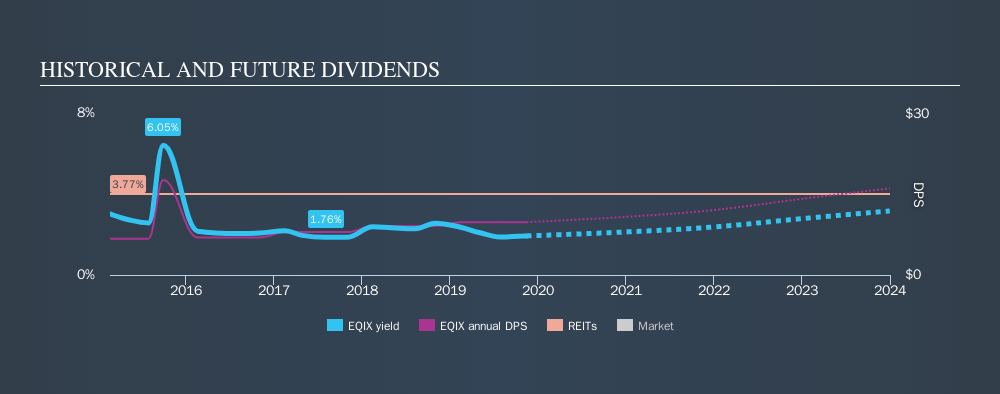- United States
- /
- Specialized REITs
- /
- NasdaqGS:EQIX
Is It Smart To Buy Equinix, Inc. (REIT) (NASDAQ:EQIX) Before It Goes Ex-Dividend?

It looks like Equinix, Inc. (REIT) (NASDAQ:EQIX) is about to go ex-dividend in the next 4 days. This means that investors who purchase shares on or after the 19th of November will not receive the dividend, which will be paid on the 11th of December.
Equinix (REIT)'s upcoming dividend is US$2.46 a share, following on from the last 12 months, when the company distributed a total of US$9.84 per share to shareholders. Based on the last year's worth of payments, Equinix (REIT) has a trailing yield of 1.8% on the current stock price of $540.73. Dividends are an important source of income to many shareholders, but the health of the business is crucial to maintaining those dividends. We need to see whether the dividend is covered by earnings and if it's growing.
See our latest analysis for Equinix (REIT)
Dividends are typically paid from company earnings. If a company pays more in dividends than it earned in profit, then the dividend could be unsustainable. Equinix (REIT) paid out 60% of its earnings to investors last year, a normal payout level for most businesses. That said, REITs are often required by law to distribute all of their earnings, and it's not unusual to see a REIT with a payout ratio around 100%. We wouldn't read too much into this. That said, even highly profitable companies sometimes might not generate enough cash to pay the dividend, which is why we should always check if the dividend is covered by cash flow. Fortunately, it paid out only 40% of its free cash flow in the past year.
It's encouraging to see that the dividend is covered by both profit and cash flow. This generally suggests the dividend is sustainable, as long as earnings don't drop precipitously.
Click here to see the company's payout ratio, plus analyst estimates of its future dividends.

Have Earnings And Dividends Been Growing?
Businesses with strong growth prospects usually make the best dividend payers, because it's easier to grow dividends when earnings per share are improving. If earnings fall far enough, the company could be forced to cut its dividend. That's why it's comforting to see Equinix (REIT)'s earnings have been skyrocketing, up 25% per annum for the past five years. The current payout ratio suggests a good balance between rewarding shareholders with dividends, and reinvesting in growth. With a reasonable payout ratio, profits being reinvested, and some earnings growth, Equinix (REIT) could have strong prospects for future increases to the dividend.
The main way most investors will assess a company's dividend prospects is by checking the historical rate of dividend growth. Equinix (REIT) has delivered an average of 7.8% per year annual increase in its dividend, based on the past five years of dividend payments. We're glad to see dividends rising alongside earnings over a number of years, which may be a sign the company intends to share the growth with shareholders.
The Bottom Line
Has Equinix (REIT) got what it takes to maintain its dividend payments? We like Equinix (REIT)'s growing earnings per share and the fact that - while its payout ratio is around average - it paid out a lower percentage of its cash flow. Overall we think this is an attractive combination and worthy of further research.
Curious what other investors think of Equinix (REIT)? See what analysts are forecasting, with this visualisation of its historical and future estimated earnings and cash flow.
If you're in the market for dividend stocks, we recommend checking our list of top dividend stocks with a greater than 2% yield and an upcoming dividend.
We aim to bring you long-term focused research analysis driven by fundamental data. Note that our analysis may not factor in the latest price-sensitive company announcements or qualitative material.
If you spot an error that warrants correction, please contact the editor at editorial-team@simplywallst.com. This article by Simply Wall St is general in nature. It does not constitute a recommendation to buy or sell any stock, and does not take account of your objectives, or your financial situation. Simply Wall St has no position in the stocks mentioned. Thank you for reading.
About NasdaqGS:EQIX
Equinix
Equinix (Nasdaq: EQIX) is the world's digital infrastructure company.
Established dividend payer with adequate balance sheet.
Similar Companies
Market Insights
Community Narratives





